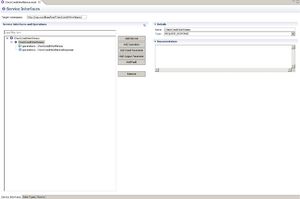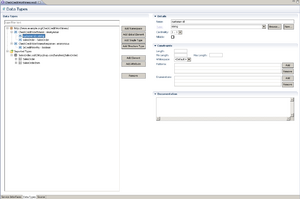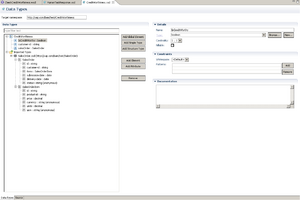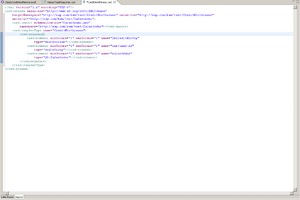Notice: this Wiki will be going read only early in 2024 and edits will no longer be possible. Please see: https://gitlab.eclipse.org/eclipsefdn/helpdesk/-/wikis/Wiki-shutdown-plan for the plan.
WTP/Service Interface and Data Types Editors/Proposal
The Service Interface & Data Types Editors project is a proposed open source project under the WTP Incubator project.
This proposal is in the Project Proposal Phase (as defined in the Eclipse Development Process) and is written to declare its intent and scope. We solicit additional participation and input from the Eclipse community. Please send all feedback to the Webtools incubator forum.
Contents
Background
The Web Services Definition Language (WSDL) 1.1[1] has been used world-wide for the definition of Web Services ensuring well-defined, system-independent and interoperable contracts for reliable communication among different structures and organizations thus being the foundation of many industry specific solutions in the area of Service Oriented Architecture (SOA) and Business Process Management (BPM). The primary type-system, utilized for definition of data types within a WS interface as part of an operation signature, has been the XML Schema Definition (XSD) [2][3]. As such the XML-based WSDL 1.1 and XSD artifacts are integral to the development of scalable business (A2C, B2B, etc.) solutions in distributed environment. In addition the XSD has become a prominent way to describe and validate XML documents in many use-cases, which are outside the scope of the Web Service provisioning one, e.g. data-base schema description, arbitrary XML documents validation, etc.
Yet the complexity of the aforementioned XML dialects imply considerable difficulties and a steep learning curve when it comes to the definition / modification of WSDL 1.1 and XSD models. The currently existing tooling in the Eclipse WTP project, although full-featured in terms of specification-support, does not do much to hide this complexity and has been considered to be too technology-centric by the average SOA developer. In addition it seems to be distributed in several editors and views, which to some extent makes the navigation a bit harder.
The feedback of a number of end-users, experienced in the development and maintenance of SOA/BPM-based applications, points out that they need a compact UI modeling toolset, which only gives them access to the selected set of the most commonly used entities, defined in the WSDL and XSD specifications, and makes it easier for them to quickly create and modify Web Service contracts and XSD artifacts. As part of it the early error detection and resolution as well as the rich refactoring capabilities seem to play a quite important role in the development process.
The Service Interface and Data Types editors are Eclipse form-based editors, which fully satisfy these requirements, providing easy-to-use, unified user interface and facilitating developers with quick and efficient application development in all WS and XSD related areas. In order not to restrict WSDL and XSD experts to the visual-editing capabilities of the tooling they also provide feature rich text-editing capabilities based on the WTP Structured Text Editor.
Scope
The strategic goals of the editors are reflected by the high-level definition of their scope as defined below.
High Level Requirements
- Modeling tool
- Easy to use
- Focus on developer productivity
- Focus on business use-case
- Technical details shall not be in the way of customers
In scope:
- Provisioning of the means for simplified WSDL/XSD modeling
- Reduction of the complexity, introduced by the WSDL 1.1 & XSD specifications
- Hiding the pure technical aspects and providing meaningful defaults
- Easy creation and re-use of existing XSD artifacts
Out of scope:
- Full modeling support of all aspects of the XSD & WSDL 1.1 specifications - only business-wise use-cases are supported
Description
Service Interface Editor
A standalone, multi-page, form-based Eclipse editor for modification of WSDL 1.1 documents, which gives UI modeling access to selected features of WSDL 1.1 aiming to provide exceptional ease-of-use and to boost developers' productivity. It opens files with *.wsdl extension contained in the Eclipse workspace.Features
- Service Interface modification
- Define namespace
- Define operation
- Define input/output/fault messages
- Select type for input/output/fault
- Documentation field
- Embedded Data Types Editor for advanced Data Types manipulation of inline types
- Source tab (WSDL 1.1 source modification)
- In-place / document validations
- WSDL 1.1
- WS Interoperability
- XSD
- Refactoring
- Re-use of externally defined data types
Data Type Editor
A standalone, multi-page, form-based Eclipse editor for modification of XSD documents, which gives UI modeling access to selected XSD entities aiming to provide exceptional ease-of-use and to boost developers' productivity. It is also embedded in the Service Interface editor and is utilized for UI modeling manipulations of the in-line XSD schemas, contained in a WSDL document. It opens files with *.xsd extension in the Eclipse workspace.
Features
- Types creation, modification, inheritance
- Simple & structure
- Elements
- Attributes
- Define type name & namespace
- Define type cardinality and constraints
- Documentation
- Source tab (XSD source modification)
- In-place / document validations
- XSD
- Refactoring (Renaming of all possible entities, Copy & Paste of all possible schema entities, etc.)
- Re-use of externally defined data types
Screencast
Watch the short introductory screencast: http://www.youtube.com/watch?v=iSmidd2692E
When To Use
The editors are to be used whenever the development productivity needs to be high and the modeling experience is not required to support all WSDL 1.1 and XSD entities, i.e. when the use-case would be similar to the Web Service interoperability, SOA and BPM ones.
Relationship with Other Eclipse Projects
The Service Interface & Data Types Editors are multipage, form-based WSDL 1.1 and XSD editors based on Eclipse EMF, MDT XSD and WTP.
They consist of
- Data Types Editor - a standalone XSD editor
- Service Interface Editor - a standalone WSDL 1.1 editor embedding the Data Types Editor for providing capabilities of visualizing and manipulating inline XSD schemas and their underlying entities
Technical Dependencies
- Eclipse Modeling Framework
- Core
- Model Query
- Model Transaction
- Validation Framework
- Eclipse Model Development Tools XSD
- Eclipse Web Tools Platform
- WST WSDL Model
- WTP Source Editing
Note: There are no proprietary/non-Eclipse dependencies.
Initial Contribution
The initial code contribution will come from SAP where the Service Interface & Data Types Editors have been originally developed. They will provide the functionality described in the Description section.
The developed plugins can be found as attachements in the following bugzilla: https://bugs.eclipse.org/bugs/show_bug.cgi?id=323696
Committers
The following individuals are going to be proposed as initial committers to the project:
- Dimitar Tenev
- Nevena Manova
- Georgi Konstantinov
- Dimitar Donchev
- Emil Simeonov
Mentors
- Kaloyan Raev
Interested Parties
The following individuals, organizations, companies and projects have expressed interest in this project:
- SAP
- WTP (TBD)
Project Scheduling (Sample Proposal, i.e. TBD)
- July - August 2010 – Project proposal
- August - September 2010 – Infrastructure setup, initial contribution
- October 2010 – First Milestone release
- October 2010 – February 2011 – respond on community feedback, graduate in the Web Tools Platform
- June 2011 – Release as part of the 2011 simultaneous release train




